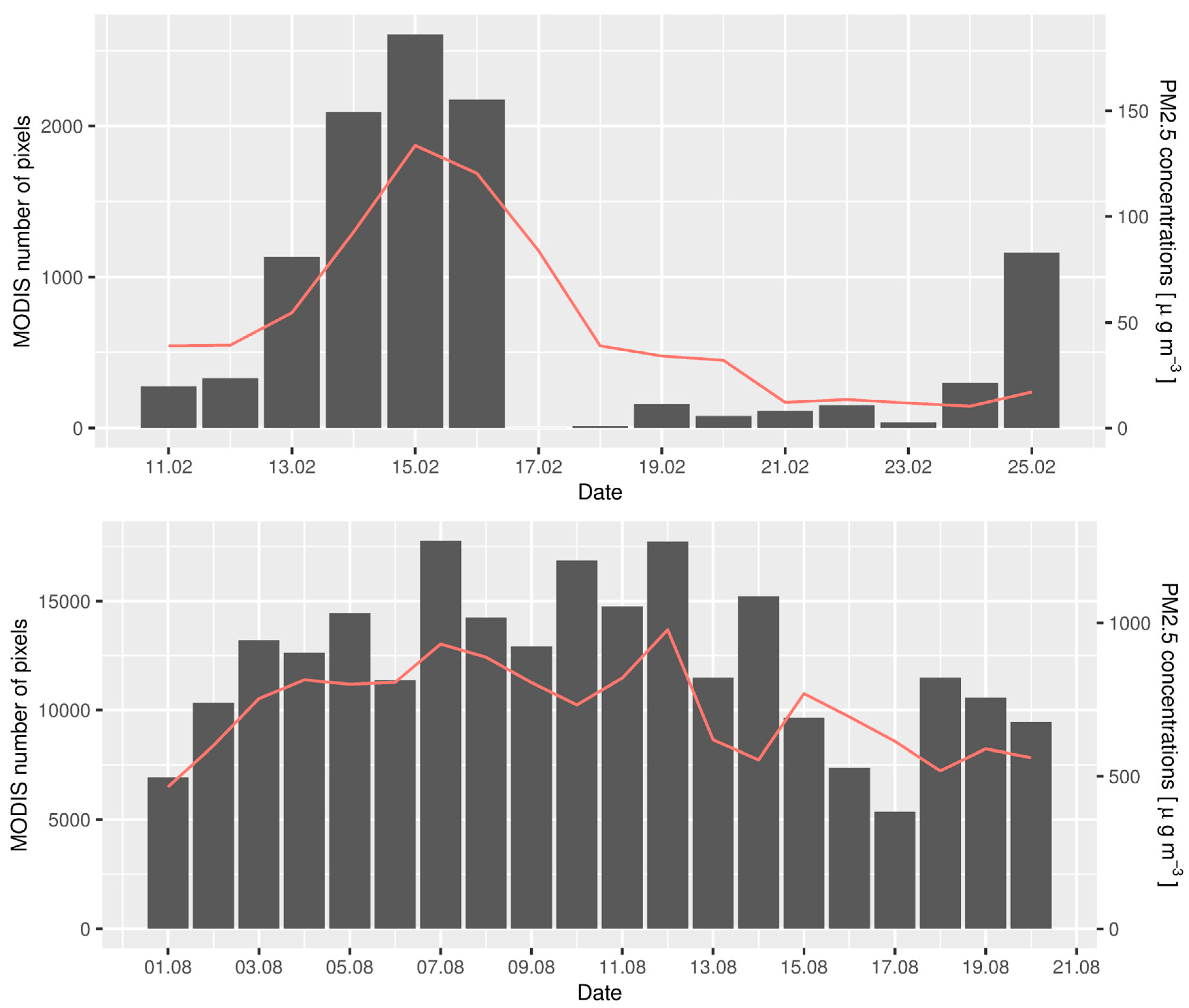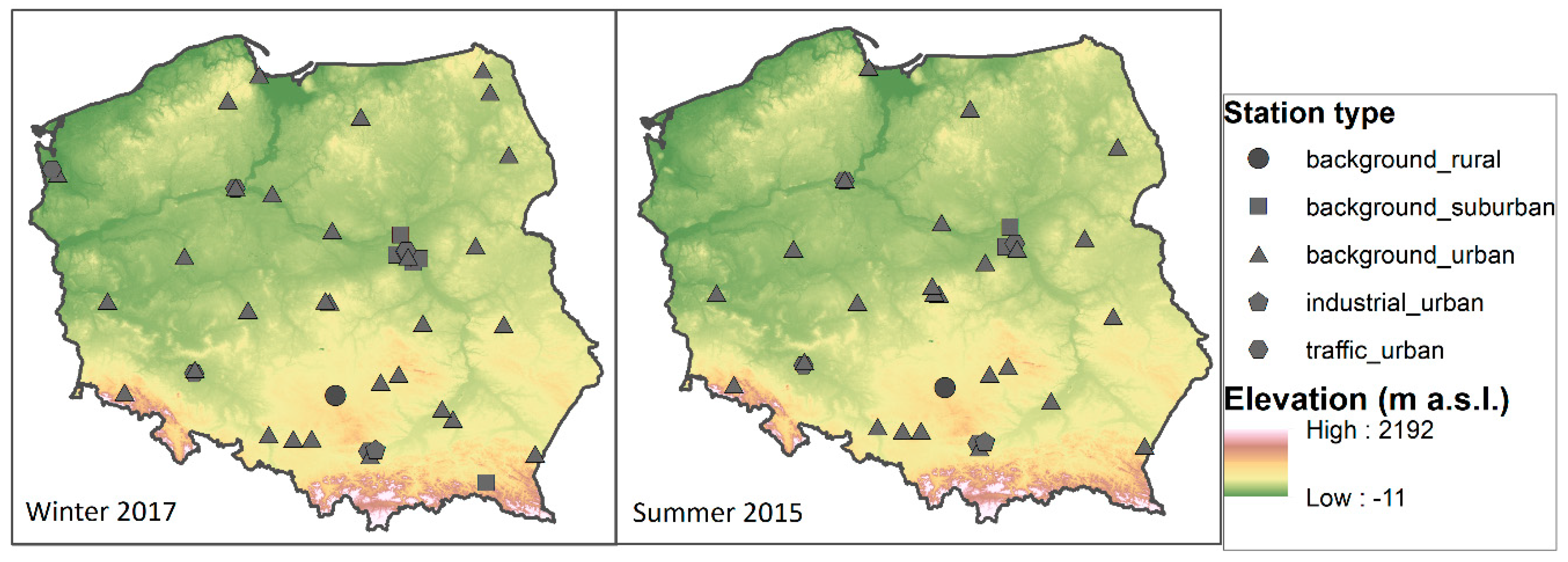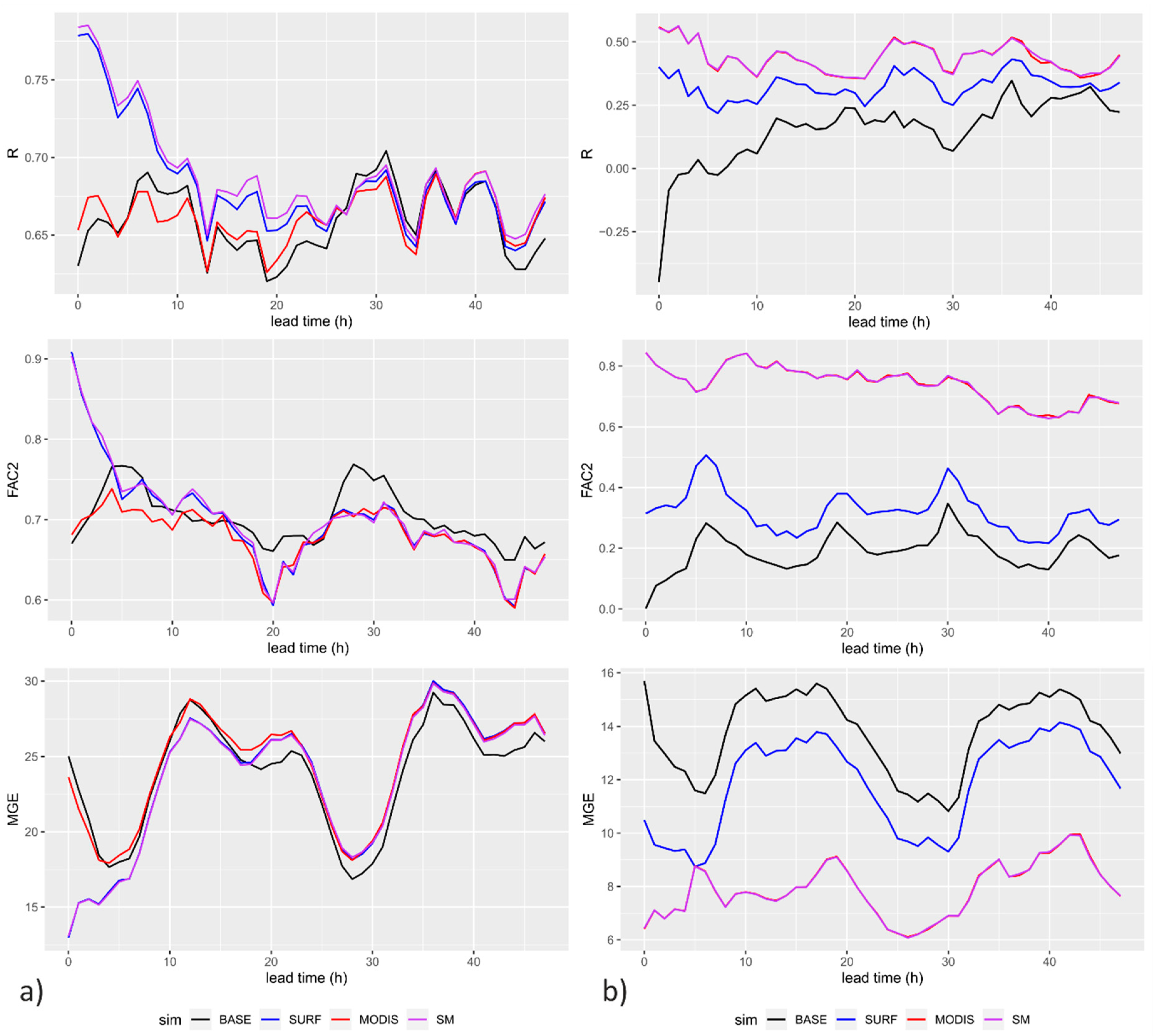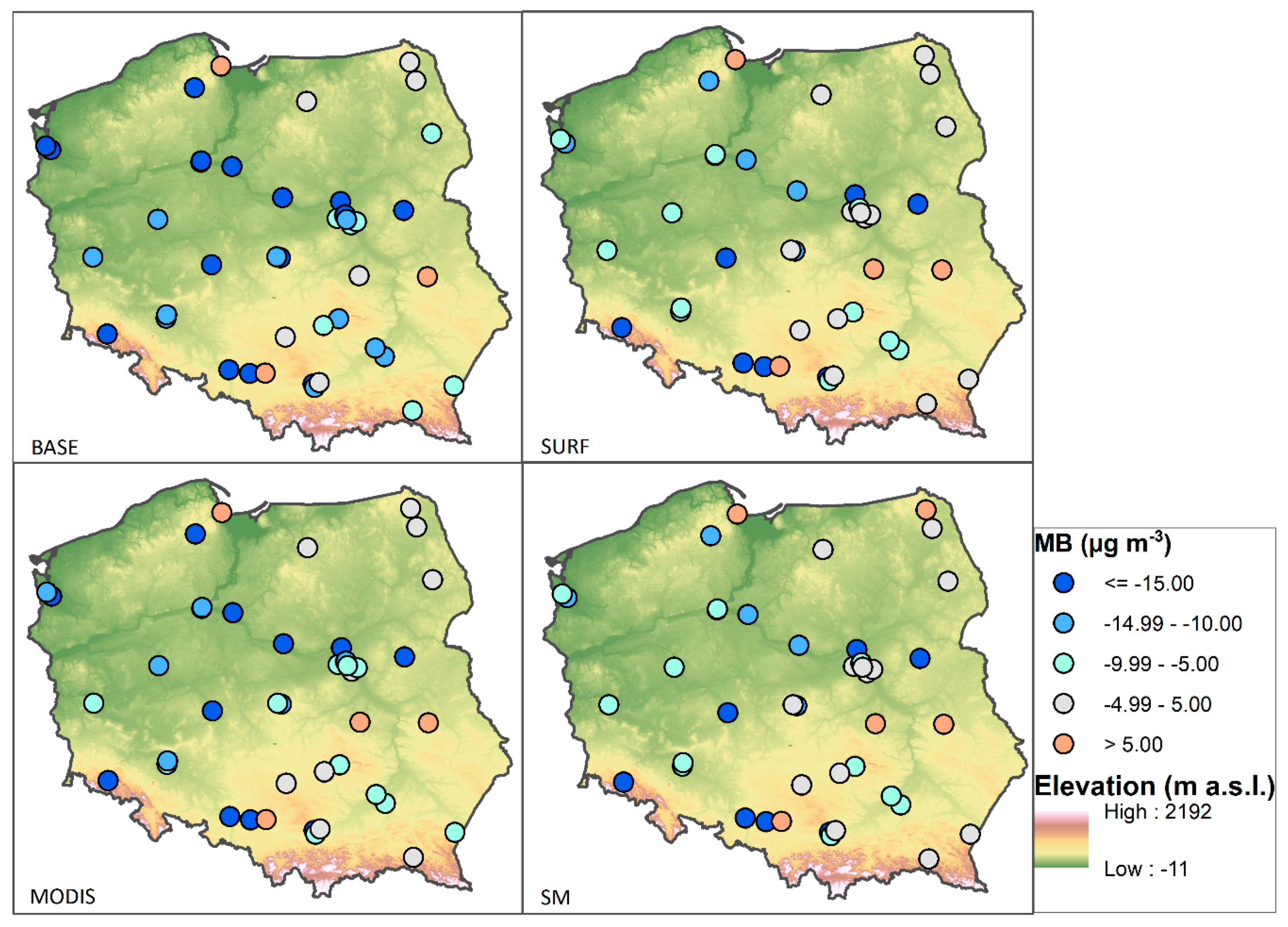Can Data Assimilation of Surface PM2.5 and Satellite AOD Improve WRF-Chem Forecasting? A Case Study for Two Scenarios of Particulate Air Pollution Episodes in Poland
Abstract
1. Introduction
2. Materials and Methods
2.1. The Episodes
2.2. The Modeling System and the Experiment Design
- BASE: simulation with no DA
- SURF: simulation with assimilation of surface PM2.5 observations
- MODIS: simulation with assimilation of satellite AOD observations
- SM: simulation with assimilation of both surface PM2.5 and satellite AOD data
- Probability of detection, calculated as: POD = a/(a + c)
- Success ratio, calculated as: SR = 1 – (b/(a+b))
- Bias, calculated as: BIAS = (a + b)/(a + c)
- Critical success index (also known as the threat score), calculated as: CSI = a/(a + b + c)
2.3. Surface PM2.5 Observations and Satellite Data
3. Results
3.1. General Evaluation of the Models
3.1.1. Winter Episode
3.1.2. Summer Episode
3.2. Temporal and Spatial Variability in the Model’s Performance
3.2.1. Winter Episode
3.2.2. Summer Episode
4. Discussion
4.1. The BASE Simulation
4.2. Data Assimilation
5. Summary and Conclusions
- Assimilation of surface and satellite data improves the model statistics for PM2.5 concentrations calculated for the winter and summer episodes in Poland. This is indicated by a smaller bias and higher correlation coefficient as well as factor of two for simulations with DA in comparison to BASE.
- Assimilation of surface observations has a greater positive impact on the mean model results than assimilation of satellite data in the winter episode; on the contrary, assimilation of satellite data has a greater positive impact during the summer episode. Simultaneously, the best model performance for both seasons’ episodes is for simulations with both surface and satellite data assimilated. It confirms that simultaneous DA of different aerosol observations can work synergistically to improve the aerosol forecasts.
- All DA simulations show the biggest improvement in comparison to BASE at 00 lead time, and thereafter the relation between simulations with DA and BASE varies for the next few hours of simulations. In general, the positive effect of DA is greater and lasts longer in the summer episode than in winter.
Supplementary Materials
Author Contributions
Funding
Acknowledgments
Conflicts of Interest
References
- Marécal, V.; Peuch, V.-H.; Andersson, C.; Andersson, S.; Arteta, J.; Beekmann, M.; Benedictow, A.; Bergström, R.; Bessagnet, B.; Cansado, A.; et al. A regional air quality forecasting system over Europe: The MACC-II daily ensemble production. Geosci. Model Dev. 2015, 8, 2777–2813. [Google Scholar] [CrossRef]
- Hirtl, M.; Mantovani, S.; Krüger, B.C.; Triebnig, G.; Flandorfer, C.; Bottoni, M.; Cavicchi, M. Improvement of air quality forecasts with satellite and ground based particulate matter observations. Atmos. Environ. 2014, 84, 20–27. [Google Scholar] [CrossRef]
- Krynicka, J.; Drzeniecka-Osiadacz, A. Analysis of variability in PM10 concentration in the Wroclaw agglomeration. Pol. J. Environ. Stud. 2013, 22, 1091–1099. [Google Scholar]
- Reizer, M.; Juda-Rezler, K. Explaining the high PM10 concentrations observed in Polish urban areas. Air Qual. Atmos. Health 2016, 9, 517–531. [Google Scholar] [CrossRef]
- Pope, C.A.; Ezzati, M.; Dockery, D.W. Fine-particulate air pollution and life expectancy in the United States. N. Engl. J. Med. 2009, 360, 376–386. [Google Scholar] [CrossRef]
- Kampa, M.; Castanas, E. Human health effects of air pollution. Environ. Pollut. 2008, 151, 362–367. [Google Scholar] [CrossRef]
- Amato, G.D.; Cecchi, L.; Amato, M.D.; Liccardi, G. Urban Air Pollution and Climate Change as Environmental Risk Factors of Respiratory Urban Air Pollution and Climate Change as Environmental Risk Factors of Respiratory Allergy: An Update Environmental Risk Factors of Respiratory Allergy: An Update. J. Investig. Allergol. Clin. Immunol. 2010, 20, 95–102. [Google Scholar]
- Grewling, Ł.; Frątczak, A.; Kostecki, Ł.; Nowak, M.; Szymańska, A.; Bogawski, P. Biological and Chemical Air Pollutants in an Urban Area of Central Europe: Co-exposure Assessment. Aerosol Air Qual. Res. 2019, 19, 1526–1537. [Google Scholar] [CrossRef]
- Baldacci, S.; Maio, S.; Cerrai, S.; Sarno, G.; Baız, N.; Simoni, M.; Annesi-Maesano, I.; Viegi, G. Allergy and asthma: Effects of the exposure to particulate matter and biological allergens. Respir. Med. 2015, 109, 1089–1104. [Google Scholar] [CrossRef]
- Huynen, M.; Menne, B.; Behrendt, H.; Bertollini, R.; Bonini, S.; Brandao, R. Phenology and Human Health: Allergic Disorders; Health and Global Environmental Change: Rome, Italy, 2003. [Google Scholar]
- Heinzerling, L.M.; Burbach, G.J.; Edenharter, G.; Bachert, C.; Bindslev-Jensen, C.; Bonini, S.; Bousquet, J.; Bousquet-Rouanet, L.; Bousquet, P.J.; Bresciani, M.; et al. GA(2)LEN skin test study I: GA(2)LEN harmonization of skin prick testing: Novel sensitization patterns for inhalant allergens in Europe. Allergy 2009, 64, 1498–1506. [Google Scholar] [CrossRef]
- Li, Z.; Zang, Z.; Li, Q.B.; Chao, Y.; Chen, D.; Ye, Z.; Liu, Y.; Liou, K.N. A three-dimensional variational data assimilation system for multiple aerosol species with WRF/Chem and an application to PM2.5 prediction. Atmos. Chem. Phys. 2013, 13, 4265–4278. [Google Scholar] [CrossRef]
- Zang, Z.; Hao, Z.; Li, Y.; Pan, X.; You, W.; Li, Z.; Chen, D. Background error covariance with balance constraints for aerosol species and applications in variational data assimilation. Geosci. Model Dev. 2016, 9, 2623–2638. [Google Scholar] [CrossRef]
- Dumitrache, R.C.; Iriza, A.; Maco, B.A.; Barbu, C.D.; Hirtl, M.; Mantovani, S.; Nicola, O.; Irimescu, A.; Craciunescu, V.; Ristea, A.; et al. Study on the influence of ground and satellite observations on the numerical air-quality for PM10 over Romanian territory. Atmos. Environ. 2016, 143, 278–289. [Google Scholar] [CrossRef]
- Jiang, Z.; Liu, Z.; Wang, T.; Schwartz, C.S.; Lin, H.C.; Jiang, F. Probing into the impact of 3DVAR assimilation of surface PM10 observations over China using process analysis. J. Geophys. Res. Atmos. 2013, 118, 6738–6749. [Google Scholar] [CrossRef]
- Schwartz, C.S.; Liu, Z.; Lin, H.C.; McKeen, S.A. Simultaneous three-dimensional variational assimilation of surface fine particulate matter and MODIS aerosol optical depth. J. Geophys. Res. Atmos. 2012, 117, 1–22. [Google Scholar] [CrossRef]
- Pagowski, M.; Liu, Z.; Grell, G.A.; Hu, M.; Lin, H.-C.; Schwartz, C.S. Implementation of aerosol assimilation in Gridpoint Statistical Interpolation v. 3.2 and WRF-Chem v. 4.3.1. Geosci. Model Dev. Discuss. 2014, 7, 2483–2500. [Google Scholar] [CrossRef]
- Feng, S.; Jiang, F.; Jiang, Z.; Wang, H.; Cai, Z.; Zhang, L. Impact of 3DVAR assimilation of surface PM2.5observations on PM2.5forecasts over China during wintertime. Atmos. Environ. 2018, 187, 34–49. [Google Scholar] [CrossRef]
- Bocquet, M.; Elbern, H.; Eskes, H.; Hirtl, M.; Aabkar, R.; Carmichael, G.R.; Flemming, J.; Inness, A.; Pagowski, M.; Pérez Camaño, J.L.; et al. Data assimilation in atmospheric chemistry models: Current status and future prospects for coupled chemistry meteorology models. Atmos. Chem. Phys. 2015, 15, 5325–5358. [Google Scholar] [CrossRef]
- Barker, D.M.; Huang, W.; Guo, Y.-R.; Bourgeois, A.J.; Xiao, Q.N. A Three-Dimensional Variational Data Assimilation System for MM5: Implementation and Initial Results. Mon. Weather Rev. 2004, 132, 897–914. [Google Scholar] [CrossRef]
- Mazzarella, V.; Maiello, I.; Capozzi, V.; Budillon, G.; Ferretti, R. Comparison between 3D-Var and 4D-Var data assimilation methods for the simulation of a heavy rainfall case in central Italy. Adv. Sci. Res. 2017, 145194, 271–278. [Google Scholar] [CrossRef]
- Werner, M.; Kryza, M.; Pagowski, M.; Guzikowski, J. Assimilation of PM2.5 ground base observations to two chemical schemes in WRF-Chem—The results for the winter and summer period. Atmos. Environ. 2019, 200, 178–189. [Google Scholar] [CrossRef]
- Kryza, M.; Werner, M.; Dore, A. Application of degree-day factors for residential emission estimate and air quality forecasting. Int. J. Environ. Pollut. 2019, in press. [Google Scholar]
- Szkop, A.; Pietruczuk, A. Analysis of aerosol transport over southern Poland in August 2015 based on a synergy of remote sensing and backward trajectory techniques. J. Appl. Remote Sens. 2017, 11, 016039. [Google Scholar] [CrossRef]
- Werner, M.; Kryza, M.; Ojrzyńska, H.; Skjøth, C.A.; Wałaszek, K.; Dore, A.J. Application of WRF-Chem to forecasting PM10 concentration over Poland. Int. J. Environ. Pollut. 2015, 58, 280–292. [Google Scholar] [CrossRef]
- Chen, F.; Dudhia, J. Coupling an Advanced Land Surface–Hydrology Model with the Penn State–NCAR MM5 Modeling System. Part I: Model Implementation and Sensitivity. Mon. Weather Rev. 2001, 129, 569–585. [Google Scholar] [CrossRef]
- Hong, S.-Y.; Noh, Y.; Dudhia, J. A New Vertical Diffusion Package with an Explicit Treatment of Entrainment Processes. Mon. Weather Rev. 2006, 134, 2318–2341. [Google Scholar] [CrossRef]
- Iacono, M.J.; Delamere, J.S.; Mlawer, E.J.; Shephard, M.W.; Clough, S.A.; Collins, W.D. Radiative forcing by long-lived greenhouse gases: Calculations with the AER radiative transfer models. J. Geophys. Res. 2008, 113, D13103. [Google Scholar] [CrossRef]
- Morrison, H.; Thompson, G.; Tatarskii, V.; Morrison, H.; Thompson, G.; Tatarskii, V. Impact of Cloud Microphysics on the Development of Trailing Stratiform Precipitation in a Simulated Squall Line: Comparison of One- and Two-Moment Schemes. Mon. Weather Rev. 2009, 137, 991–1007. [Google Scholar] [CrossRef]
- Stockwell, W.R.; Middleton, P.; Chang, J.S.; Tang, X. The second generation regional acid deposition model chemical mechanism for regional air quality modeling. J. Geophys. Res. 1990, 95, 16343. [Google Scholar] [CrossRef]
- Chin, M.; Ginoux, P.; Kinne, S.; Torres, O.; Holben, B.N.; Duncan, B.N.; Martin, R.V.; Logan, J.A.; Higurashi, A.; Nakajima, T. Tropospheric Aerosol Optical Thickness from the GOCART Model and Comparisons with Satellite and Sun Photometer Measurements. J. Atmos. Sci. 2002, 59, 461–483. [Google Scholar] [CrossRef]
- Kuenen, J.J.P.; Visschedijk, A.J.H.; Jozwicka, M.; Denier van der Gon, H.A.C. TNO-MACC_II emission inventory; a multi-year (2003–2009) consistent high-resolution European emission inventory for air quality modelling. Atmos. Chem. Phys. 2014, 14, 10963–10976. [Google Scholar] [CrossRef]
- Pagowski, M.; Grell, G.A.; McKeen, S.A.; Peckham, S.E.; Devenyi, D. Three-dimensional variational data assimilation of ozone and fine particulate matter observations: Some results using the Weather Research and Forecasting-Chemistry model and Grid-point Statistical Interpolation. Q. J. R. Meteorol. Soc. 2010, 136, 2013–2024. [Google Scholar] [CrossRef]
- Wei, J.; Li, Z.; Peng, Y.; Sun, L. MODIS Collection 6.1 aerosol optical depth products over land and ocean: Validation and comparison. Atmos. Environ. 2018, 201, 428–440. [Google Scholar] [CrossRef]
- Sayer, A.M.; Hsu, N.C.; Bettenhausen, C.; Jeong, M.J. Validation and uncertainty estimates for MODIS Collection 6 “deep Blue” aerosol data. J. Geophys. Res. Atmos. 2013, 118, 7864–7872. [Google Scholar] [CrossRef]
- Chief Inspectorate for Environmental Protection. Available online: http://powietrze.gios.gov.pl (accessed on 15 January 2019).
- Lin, C.; Heal, M.R.; Vieno, M.; MacKenzie, I.A.; Armstrong, B.G.; Butland, B.K.; Milojevic, A.; Chalabi, Z.; Atkinson, R.W.; Stevenson, D.S.; et al. Spatiotemporal evaluation of EMEP4UK-WRF v4.3 atmospheric chemistry transport simulations of health-related metrics for NO2, O3, PM10, and PM2. 5 for 2001–2010. Geosci. Model Dev. 2017, 10, 1767–1787. [Google Scholar] [CrossRef]
- Saide, P.E.; Spak, S.N.; Carmichael, G.R.; Mena-Carrasco, M.A.; Yang, Q.; Howell, S.; Leon, D.C.; Snider, J.R.; Bandy, A.R.; Collett, J.L.; et al. Evaluating WRF-Chem aerosol indirect effects in Southeast Pacific marine stratocumulus during VOCALS-REx. Atmos. Chem. Phys. 2012, 12, 3045–3064. [Google Scholar] [CrossRef]
- Dore, T.; Kryza, M.; Hall, J.R.; Hallsworth, S.; Keller, V.J.D.; Vieno, M.; Sutton, M.A. The influence of model grid resolution on estimation of national scale nitrogen deposition and exceedance of critical loads. Biogeosciences 2012, 9, 1597–1609. [Google Scholar] [CrossRef]
- Aksoyoglu, S.; Keller, J.; Barmpadimos, I.; Oderbolz, D.; Lanz, V.A.; Prévǎt, A.S.H.; Baltensperger, U. Aerosol modelling in Europe with a focus on Switzerland during summer and winter episodes. Atmos. Chem. Phys. 2011, 11, 7355–7373. [Google Scholar] [CrossRef]
- Werner, M.; Kryza, M.; Wind, P. High resolution application of the EMEP MSC-W model over Eastern Europe—Analysis of the EMEP4PL results. Atmos. Res. 2018, 212, 6–22. [Google Scholar] [CrossRef]
- Wu, J.B.; Xu, J.; Pagowski, M.; Geng, F.; Gu, S.; Zhou, G.; Xie, Y.; Yu, Z. Modeling study of a severe aerosol pollution event in December 2013 over Shanghai China: An application of chemical data assimilation. Particuology 2015, 20, 41–51. [Google Scholar] [CrossRef]






| Statistic | Formula | Range of Values | Expected Value |
|---|---|---|---|
| Factor of Two (FAC2) | Fraction of data that fulfil the condition: | [0,1] | 1 |
| Mean Bias (MB) | [–Ō, +∞] | 0 | |
| Mean Gross Error (MGE) | [0, +∞] | 0 | |
| Normalized Mean Bias (NMB) | [–1, +∞] | 0 | |
| Normalized Mean Gross Error (NMGE) | [0, +∞] | 0 | |
| Correlation Coefficient (R) | [[–1,1] | 1 |
| Event Observed | ||
|---|---|---|
| Event Forecast | Yes | No |
| Yes | a | b |
| No | c | d |
| PM2.5 WINTER | ||||||
| SIMULATION | FAC2 | MB | MGE | NMB | NMGE | R |
| BASE | 0.71 | –12.31 | 23.85 | –0.25 | 0.48 | 0.64 |
| SURF | 0.72 | –6.71 | 22.17 | –0.14 | 0.45 | 0.68 |
| MODIS | 0.71 | –11.96 | 23.71 | –0.24 | 0.48 | 0.64 |
| SM | 0.72 | –6.58 | 22.15 | –0.13 | 0.45 | 0.68 |
| PM2.5 SUMMER | ||||||
| FAC2 | MB | MGE | NMB | NMGE | R | |
| BASE | 0.18 | –13.34 | 14.04 | –0.71 | 0.75 | 0.16 |
| SURF | 0.34 | –10.88 | 11.65 | –0.58 | 0.62 | 0.30 |
| MODIS | 0.78 | 0.28 | 7.76 | 0.01 | 0.41 | 0.38 |
| SM | 0.78 | 0.29 | 7.76 | 0.02 | 0.41 | 0.38 |
© 2019 by the authors. Licensee MDPI, Basel, Switzerland. This article is an open access article distributed under the terms and conditions of the Creative Commons Attribution (CC BY) license (http://creativecommons.org/licenses/by/4.0/).
Share and Cite
Werner, M.; Kryza, M.; Guzikowski, J. Can Data Assimilation of Surface PM2.5 and Satellite AOD Improve WRF-Chem Forecasting? A Case Study for Two Scenarios of Particulate Air Pollution Episodes in Poland. Remote Sens. 2019, 11, 2364. https://doi.org/10.3390/rs11202364
Werner M, Kryza M, Guzikowski J. Can Data Assimilation of Surface PM2.5 and Satellite AOD Improve WRF-Chem Forecasting? A Case Study for Two Scenarios of Particulate Air Pollution Episodes in Poland. Remote Sensing. 2019; 11(20):2364. https://doi.org/10.3390/rs11202364
Chicago/Turabian StyleWerner, Małgorzata, Maciej Kryza, and Jakub Guzikowski. 2019. "Can Data Assimilation of Surface PM2.5 and Satellite AOD Improve WRF-Chem Forecasting? A Case Study for Two Scenarios of Particulate Air Pollution Episodes in Poland" Remote Sensing 11, no. 20: 2364. https://doi.org/10.3390/rs11202364
APA StyleWerner, M., Kryza, M., & Guzikowski, J. (2019). Can Data Assimilation of Surface PM2.5 and Satellite AOD Improve WRF-Chem Forecasting? A Case Study for Two Scenarios of Particulate Air Pollution Episodes in Poland. Remote Sensing, 11(20), 2364. https://doi.org/10.3390/rs11202364







